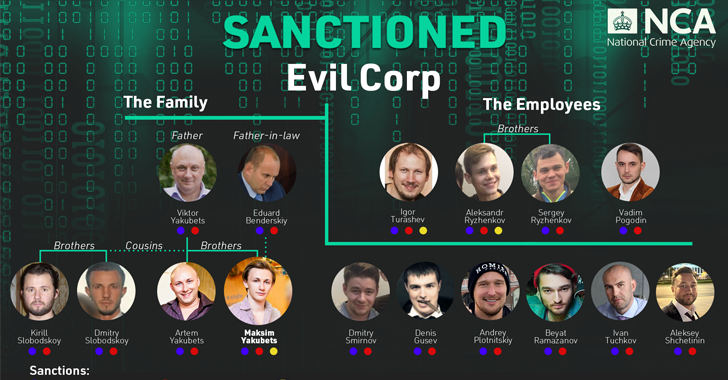THN Cybersecurity Recap: Top Threats and Trends (Sep 30 - Oct 6)
|
|
|
|
|
|
Powered by: |
Older messages
Largest-Ever DDoS Attack Just Occurred—3.8 Tbps in Just 65 Seconds!
Saturday, October 5, 2024
THN Daily Updates Newsletter cover Mastering Spring Boot 3.0 ($31.99 Value) FREE for a Limited Time A comprehensive guide to building scalable and efficient backend systems with Java and Spring
Largest-Ever DDoS Attack Just Occurred—3.8 Tbps in Just 65 Seconds!
Friday, October 4, 2024
THN Daily Updates Newsletter cover Mastering PowerShell Scripting, Fifth Edition ($35.99 Value) FREE for a Limited Time Automate repetitive tasks and simplify complex administrative tasks using
LockBit Ransomware and Evil Corp Members Arrested and Sanctioned in Joint Global Effort
Thursday, October 3, 2024
THN Daily Updates Newsletter cover Kubernetes Anti-Patterns ($39.99 Value) FREE for a Limited Time As the popularity of Kubernetes continues to grow, it's essential to understand and navigate the
eBook: Overcoming the Security Blind Spots of Service Accounts
Wednesday, October 2, 2024
Discover how to secure overlooked service accounts that pose hidden cybersecurity risks
Researchers Warn of Ongoing Attacks Exploiting Critical Zimbra Postjournal Flaw
Wednesday, October 2, 2024
THN Daily Updates Newsletter cover [Watch LIVE] Modernization of Authentication: Passwords vs Passwordless and MFA Discover the Future of Cybersecurity: Understand the Role of MFA and Passwords in a
You Might Also Like
AI CAPTCHA Fails Are the Internet’s New Comedy Show!
Thursday, February 27, 2025
Top Tech Content sent at Noon! Boost Your Article on HackerNoon for $159.99! Read this email in your browser How are you, @newsletterest1? 🪐 What's happening in tech today, February 27, 2025? The
Say Goodbye to Type Erasure
Thursday, February 27, 2025
View in browser 🔖 Articles Practical Kotlin: When and How to Use inline reified, noinline, and crossinline Master Kotlin's inline reified functions to tackle type erasure and boost performance!
SRE Weekly Issue #464
Thursday, February 27, 2025
View on sreweekly.com A message from our sponsor, incident.io: For years, on-call has felt more like a burden than a solution. But modern teams are making a change. On Feb 26 at 1 PM EST, hear why—and
Hands On: New VS Code Insiders Build Creates Web Page from Image in Seconds, More
Thursday, February 27, 2025
Home | News | How To | Webcasts | Whitepapers | Advertise .NET Insight February 27, 2025 THIS ISSUE SPONSORED BY: ■ Visual Studio Live! Las Vegas: .NET Developer Training Conference ■ VSLive! 4-Day
Re: Tomorrow's Password Class: How to sign up!
Thursday, February 27, 2025
Hi there, Do you reuse passwords? Do you struggle to remember unique passwords across accounts? Have you tried setting up a password manager but found it to be a hassle? You might not realize how
Documenting Event-Driven Architecture with EventCatalog and David Boyne
Thursday, February 27, 2025
If you're wondering on how to document Event-Driven Architecture, or you don't know that you should, I have something for you. We discussed with David Boyne, why data governance practices and
wpmail.me issue#708
Thursday, February 27, 2025
wpMail.me wpmail.me issue#708 - The weekly WordPress newsletter. No spam, no nonsense. - February 27, 2025 Is this email not displaying correctly? View it in your browser. News & Articles Shaping
Hackers stole 1Password logins - here's how
Thursday, February 27, 2025
Amazon AI races ahead; Research agents; Smartwatch trade-in -- ZDNET ZDNET Tech Today - US February 27, 2025 thief stealing passwords Hackers stole this engineer's 1Password database. Could it
New Golang-Based Backdoor Uses Telegram Bot API for Evasive C2 Operations
Thursday, February 27, 2025
THN Daily Updates Newsletter cover ⚡ LIVE WEBINAR ➟ Building Resilient Identity: Reducing Security Debt in 2025 Attacks Evolve, So Can Your Defenses--Learn How to Mitigate Risk and Optimize Identity
Reminder: What developer productivity metrics actually measure
Thursday, February 27, 2025
You are receiving this email because you subscribed to microservices.io. Considering migrating a monolith to microservices? Struggling with the microservice architecture? I can help: architecture


